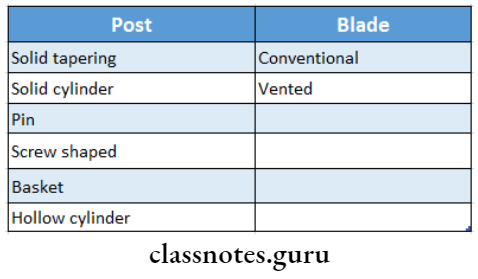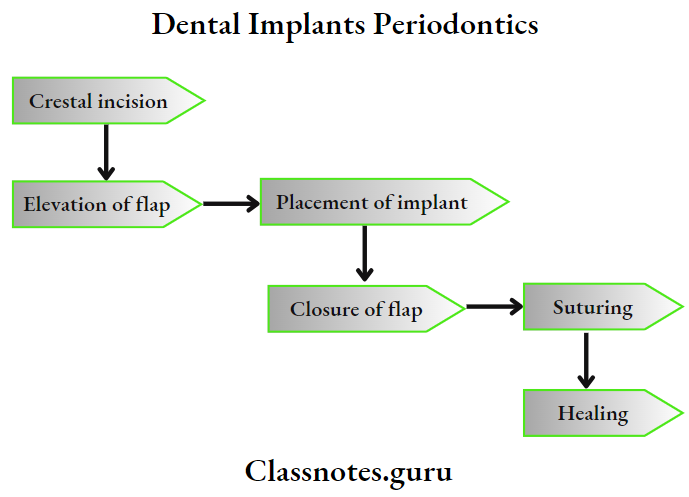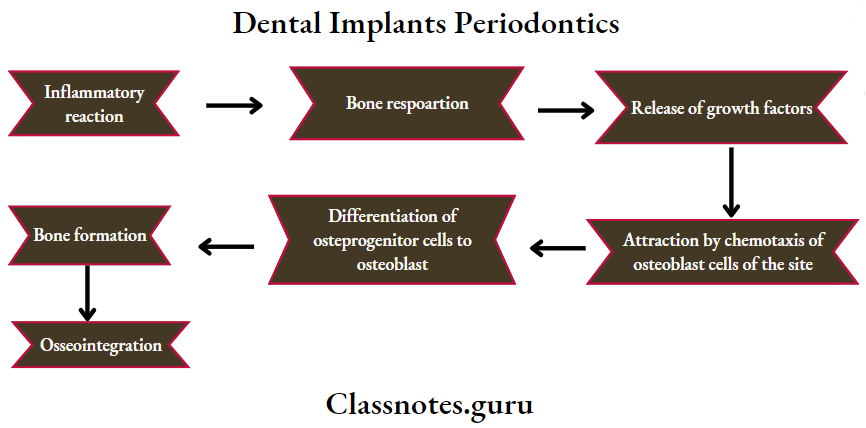Dental Implants Definitions
Dental Implants
Dental Implants is an integral component of the oral implant complex, which also consists of supportive bone, interposed keratinized and mucosal oral soft tissues, and prosthetic superstructure.
Structure of dental Implants:

Peri-implantitis
- Peri-implantitis is a progressive peri-implant bone loss in conjunction with soft tissue inflammatory lesions.
Osseointegration
- Osseointegration is defined as the direct structural and functional connection between ordered, living bone and the surface of a load-bearing implant without intervening soft tissues
Osteoconduction.
- Osteoconduction is an effect by which the matrix of the graft forms a scaffold that favors outside cells to penetrate the graft and form new bone
Osteoinduction
- A process by which graft material is capable of promoting cementogenesis, osteogenesis, and new periodontal ligament
Read And Learn More: Periodontics Question and Answers
Dental Implants Important Notes
1. Classification of implants
- Based on shape and forms
- Endosteal
- Subperiosteal
- Transosteal
- Intramucosal
- Endodontic

- Based on Surface characteristic
- Titanium plasma sprayed coating
- Sand blasting-surface etching
- Laser-induced surface roughening
- Hydroxyapatite coating
Dental Implants Long Essays
Question 1. Define Osseointegration and classify dental. implants. Add a note on the maintenance of im- plants.
Answer:
Classify dental Osseointegration
Classify dental Definition:
- It is defined as the direct structural and functional connection between ordered, living bone and the surface of a load-bearing implant without intervening soft tissue
- It is a fundamental requirement and essential component for implant success
Classify dental Maintenance Of Implants
1. At the office
- The patient is recalled at regular intervals to provide optimal preventive services
- Probing pocket depth and mucosal margins are notes
- Radiographic crestal bone levels are established
- Evaluation is done initially after 1 day, 1 month, 3 months, 6 months, and then at yearly intervals
- At every visit following evaluation is done
- Evaluation of soft tissue around the implant
- Implant mobility
- Prosthesis
- Radiograph
- Plaque and calculus scores
- Debridement of the implant should be carried out with plastic instruments that do not damage the implant surface
- A rubber cup can be used to polish the implant surface with a non-abrasive toothpaste, fine polishing paste, or tin oxide
2. Home care methods
- A soft circular toothbrush is used around implant restoration
- Powered and sonic toothbrushes are used around titanium implants
- Foam tips, interproximal brushes, and disposable wooden picks are used for plaque removal from embrasures
- Chemical antiplaque agents can be delivered with interdental aids
- Every implant patient requires lifetime careful maintenance to ensure implant health and longevity
Question 2. Dental implants.
Answer:
Dental Implants is an integral component of the oral implant complex, which also consists of supportive bone, interposed keratinized and mucosal oral soft tissues, and prosthetic superstructure.
Dental implants Material Used:
Dental implants Metals:
- Stainless steel
- Gold
- Titanium
- Tantalum
- Zirconium
Dental implants Ceramics:
- Aluminium oxide
- Titanium oxide
Dental implants Calcium Phosphate:
Bioactive and Biodegradable Ceramic:
- Hydroxyapatite
- Bioglass
- Carbon
Dental implants Polymers:
- Polymethyl methacrylate
- Polytetrafluoroethylene
- Polyethylene
- Polypropylene
Dental implants Indications:
1. Edentulous patient:
- Edentulous mandible
- Edentulous maxilla
2. Partially edentulous:
- Free end edentulous
- Multiple missing
3. Single tooth loss:
Dental implants Contraindications:
- Diseases
- Uncontrolled DM
- Malignancy
- Disease of CT
- Blood dyscrasia
- Malignancy
- Psychologic disorders
- Iatrogenic
- Immunosuppressant therapy
- Drug addiction
- Radiation to jaw
Dental implants Procedure:

Dental Implants Short Essays
Question 1. Perl-Implantis.
Answer:
- Perl-Implantis is a progressive peri-implant bone loss in conjunction with soft tissue inflammatory lesions.
- Perl-Implantis begins at the coronal portion of the implant.
Perl-Implantis Clinical Features:
- Erythema over the area
- Bleeding on probing
- Pocket formation
- Bone destruction
- Suppuration
- Presence of calculus
- Tooth mobility present
Perl-Implantis Diagnosis:
- Bone loss
- Clinical attachment loss
Perl-Implantis Management:
- Occlusal therapy – Occlusal correction
- Anti-infective therapy
- Scaling and root planning
- 0.12% chlorhexidine
Perl-Implantis Surgical Techniques:
- Correction of bone defects
- Re-osseointegration
- Maintenance
- Recall visits planned for at least every 3 months
Question 2. Osseointegration
Answer:
Osseointegration Definition:
- It is defined as the direct structural and functional connection between ordered, living bone and the surface of a load-bearing implant without intervening soft tissues
- It is a fundamental requirement and essential component for implant success
Osseointegration Process:

Osseointegration Requirements:
- Immobility of implant relative to the bone
- Avoid excessive occlusal forces
- Proper vascular supply and oxygen tension
- A strict aseptic technique should be maintained
- Profuse irrigation during drilling
Osseointegration Significance:
- Once osseointegration is achieved, implants can resist and function under occlusal forces for many years
Question 3. Failures of implants
Answer:
Failures Of Implants Are Due To:
1. Improper patient selection:
- Patients who are unmotivated to control plaque
- Chronic smokers
- Patients with systemic conditions like uncontrolled diabetes
- Patients with insufficient quality and quantity of A process by which graft material is capable of promoting- bone to support the implant fixture
2. Surgical complications:
- Oversized osteotomy site preparation
- Broken burs
- Improper angulation
- Inappropriate instrumentation
- Perforation
- Hemorrhage
- Inadequate amount of soft tissue
3. Complication in early stages:
- Postoperative infections
- Dysaesthesia
- Dehiscence
- Sinusitis
- Radiolucencies
- Mobility
4. Late failures:
- Mechanical complications
- Occlusal overloading
- As osseointegrated implants have no periodontal ligament, the adverse forces generated by occlusal activity may lead to high stress and microfractures in the coronal bone to im- plant contact
- Abutment screw fracture
- Biological complication
- They are bacterial in origin
- Characterized by bone loss combined with soft tissue inflammatory response that- demonstrates suppuration with probing depth greater than 6 mm
- Presence of pockets, bleeding on probing, and purulence
Question 4. Osteoinduction, osteoconduction, osseointe-gradation
Answer:
Osteoconduction:
Osteoconduction is an effect by which the matrix of the graft forms a scaffold that favors outside cells to penetrate the graft and form new bone
Osteoinduction:
- A process by which graft material is capable of promoting cementogenesis, osteogenesis, and new periodontal ligament
Osseointegration:
- It is defined as the direct structural and functional connection between ordered, living bone and the surface of a load-bearing implant without intervening soft tissues
- It is a fundamental requirement and essential component for implant success
Question 5. Maintenance of dental implants
Answer:
1. At the office:
- The patient is recalled at regular intervals to provide optimal preventive services
- Probing pocket depth and mucosal margins are notes
- Radiographic crestal bone levels are established
- Evaluation is done initially after 1 day, 1 month, 3 months, 6 months, and then at yearly intervals At every visit following evaluation is done
- Evaluation of soft tissue around the implant
- Implant mobility
- Prosthesis
- Radiograph
- Plaque and calculus scores
- Debridement of the implant should be carried out with plastic instruments that do not damage the implant surface
- A rubber cup can be used to polish the implant sur- face with a non-abrasive toothpaste, fine polishing paste, or tin oxide
2. Home care methods:
- A soft circular toothbrush is used around implant restoration
- Powered and sonic toothbrushes are used around
- Foam tips, interproximal brushes, and disposable wooden picks are used for plaque removal from embrasures
- Chemical antiplaque agents can be delivered with interdental aids
- Every implant patient requires lifetime careful maintenance to ensure implant health and longevity
Question 6. Biology of soft tissue around an implant.
Answer:
- Mucosal tissues around intraosseous implants form a tightly adherent band consisting of dense collagenous lamina propria
- It is covered by keratinized stratified squamous epithelium
- Implant epithelium junction is similar to junctional epi-thelium
- The epithelial cells are attached to the titanium implant employing hemidesmosomes and basal lamina
- A biologic seal exists between epithelial cells and implant
- Sulcus forms around implant lined with sulcular epithelium that is continuous apically
- Collagen fibers are non-attached and run parallel to the implant surface
Dental Implants Short Answers
Question 1. Home care methods for implant maintenance.
Answer:
- A soft circular toothbrush is used around implant restoration
- Powered and sonic toothbrushes are used around titanium implants
- Foam tips, interproximal brushes, and disposable wooden picks are used for plaque removal from embrasures
- Chemical antiplaque agents can be delivered with inter-dental aids
- Every implant patient requires lifetime careful maintenance to ensure implant health and longevity
Question 2. Implant-bone interface
Answer:
- The relationship between implant and bone involves mechanisms like
1. Fibro-osseous integration:
- When soft tissues are interposed between surface and bone, it is known as fibro-osseous integration.
2. Osseointegration:
- It is defined as the direct structural and functional connection between ordered, living bone and the surface of a load-bearing implant without intervening soft tissues
- It is a fundamental requirement and essential component for implant success
3. Biointegration:
- It is achieved in cases where the implant is coated with bioactive materials like hydroxyapatite
- These materials stimulate bone formation
Dental Implants Viva Voce
- The epithelial cell attaches with the implant surface by hemidesmosomes
- The probing depth of 3 mm with no bleeding around 15. The minimum amount of bone required all around an implant is presumed to be healthy
- The arrangement of collagen fibers around an implant is parallel and unattached
- Functional ankylosis is a synonym for osseointegration
- The critical temperature of bone cells is 47°C for 1 min
- Osteoclasts are derived from monocytes
- The oxide layer on the titanium surface mainly contains titanium dioxide
- The probable reason for poorer clinical outcomes with implants in the posterior maxilla is the deficiency in primary stability
- Periotest device is used for detecting the mobility of both the implants and teeth
- The vascular supply of the peri-implant gingival tissue is less than that of gingival tissue around teeth
- The inflammatory reaction in the soft tissues around implants is regarded as periimplantitis
- The term osseoperception refers to tactile sensitivity at the bone-implant surface
- The noninvasive method to assess the implant mobility is the resonance frequency analyzer
- An absolute contraindication for implant therapy is radiotherapy of the head and neck
- The minimum amount of bone required all around an implant after its placement is 1-1.5 mm
- Modification of implant surfaces using the additive technique includes HA coating and oxidative process
- The subtractive implant surface modifications include acid itching and sandblasting
- The recommended speed for drilling the surgical site for implant placement is 800-12

